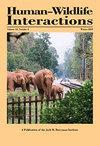Resident Perceptions of Human–Beaver Conflict in a Rural Landscape in Alberta, Canada
IF 0.9
4区 环境科学与生态学
Q4 BIODIVERSITY CONSERVATION
引用次数: 4
Abstract
The North American beaver (Castor canadensis) plays a key ecological role in wetland systems, yet their activities can result in costly damage to human infrastructure. Although qualitative research on human perceptions of beavers is rare, studies on human– beaver conflict in the United States identified generally positive attitudes toward beavers and opposition to lethal management, yet in Alberta, Canada, 79% of municipalities that managed beavers reported using trapping and shooting to remove problem beavers. Given the important ecological contributions of beavers and their potential conflict with humans, qualitative research is needed to assess perspectives of stakeholders who directly experience beaver-related impacts. To address this need, from August to September 2014, we conducted semi-structured, in-person interviews with 9 residents who lived in rural areas of Beaver County, Alberta, Canada, where the potential for human–beaver conflict was high. This pilot study involved purposive sampling to select a sample of county residents who had direct interactions with beavers on or adjacent to their properties. We found that perceptions of beaver-related impacts varied across individuals, although many respondents emphasized negative impacts to agricultural production. There were also conflicts concerning local government management actions, including both support for and opposition to lethal control. This lack of consensus among the public poses a challenge to management agencies that lack time and resources to consult with all stakeholders on a multitude of issues related to human– wildlife interactions. However, our results suggest that consultation with landowners by the government is necessary to fully understand the negative impacts residents experience, the positive impacts they desire, and the socially acceptable means for managing them.加拿大阿尔伯塔省乡村景观中居民对人与海狸冲突的看法
北美海狸(Castor canadensis)在湿地系统中起着关键的生态作用,但它们的活动可能会对人类基础设施造成昂贵的破坏。虽然关于人类对海狸的看法的定性研究很少,但在美国,关于人与海狸冲突的研究表明,人们普遍对海狸持积极态度,反对致命的管理,然而在加拿大阿尔伯塔省,79%管理海狸的市政当局报告说,他们使用陷阱和射击来清除问题海狸。鉴于海狸的重要生态贡献及其与人类的潜在冲突,需要进行定性研究,以评估直接经历海狸相关影响的利益相关者的观点。为了解决这一需求,从2014年8月到9月,我们对居住在加拿大阿尔伯塔比弗县农村地区的9名居民进行了半结构化的面对面访谈,那里人类与海狸冲突的可能性很高。这项试点研究包括有目的的抽样,以选择与他们的财产或附近的海狸直接互动的县居民样本。我们发现,尽管许多受访者强调对农业生产的负面影响,但个人对海狸相关影响的看法各不相同。当地政府的管理行动也存在冲突,包括对致命控制的支持和反对。公众之间缺乏共识给管理机构带来了挑战,因为它们缺乏时间和资源,无法就人类与野生动物互动相关的众多问题与所有利益相关者进行磋商。然而,我们的研究结果表明,政府有必要与土地所有者进行协商,以充分了解居民所经历的负面影响,他们希望得到的积极影响,以及社会可接受的管理方法。
本文章由计算机程序翻译,如有差异,请以英文原文为准。
求助全文
约1分钟内获得全文
求助全文
来源期刊

Human–Wildlife Interactions
Environmental Science-Nature and Landscape Conservation
CiteScore
2.80
自引率
0.00%
发文量
0
审稿时长
11 weeks
期刊介绍:
Human–Wildlife Interactions (HWI) serves the professional needs of the wildlife biologist and manager in the arena of human–wildlife conflicts/interactions, wildlife damage management, and contemporary wildlife management. The intent of HWI is to publish original contributions on all aspects of contemporary wildlife management and human–wildlife interactions with an emphasis on scientific research and management case studies that identify and report innovative conservation strategies, technologies, tools, and partnerships that can enhance human–wildlife interactions by mitigating human–wildlife conflicts through direct and indirect management of wildlife and increased stakeholder engagement. Our intent is to promote a dialogue among wildlife professionals concerning contemporary management issues. As such, we hope to provide a repository for wildlife management science and case studies that document and share manager experiences and lessons learned.
 求助内容:
求助内容: 应助结果提醒方式:
应助结果提醒方式:


